HSSW 504: Child Protection Act, OOHC & DECIDE Model Application
VerifiedAdded on 2023/01/10
|12
|3456
|36
Essay
AI Summary
This essay delves into the legal framework surrounding child protection, focusing on the Children and Young Persons (Care and Protection) Act 1998 and Out-of-Home Care (OOHC). It examines the administrative principles of the Act, emphasizing the importance of considering a child's cultural background, language, and any disabilities when making decisions related to their welfare. The essay also discusses the responsibilities of practitioners working with children in OOHC, including preventing abuse and neglect, maintaining accurate records, and promoting healthy relationships. Furthermore, it presents a case study involving two children and their mother, applying the DECIDE model to determine the appropriate course of action to ensure the children's safety and well-being. The essay concludes by suggesting potential interventions to improve the family's situation and safeguard the children's future, highlighting the role of various support services and legal provisions.
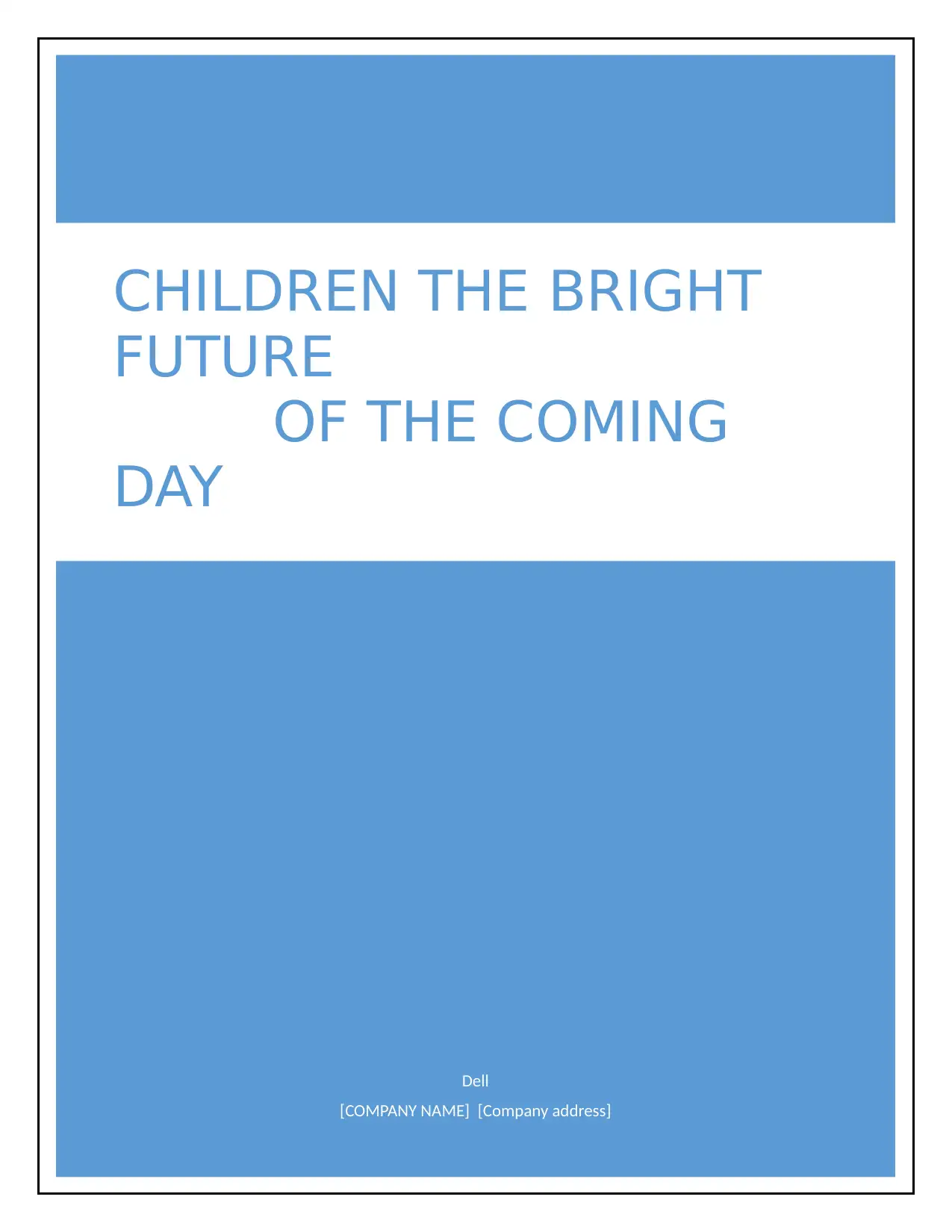
Dell
[COMPANY NAME] [Company address]
CHILDREN THE BRIGHT
FUTURE
OF THE COMING
DAY
[COMPANY NAME] [Company address]
CHILDREN THE BRIGHT
FUTURE
OF THE COMING
DAY
Paraphrase This Document
Need a fresh take? Get an instant paraphrase of this document with our AI Paraphraser
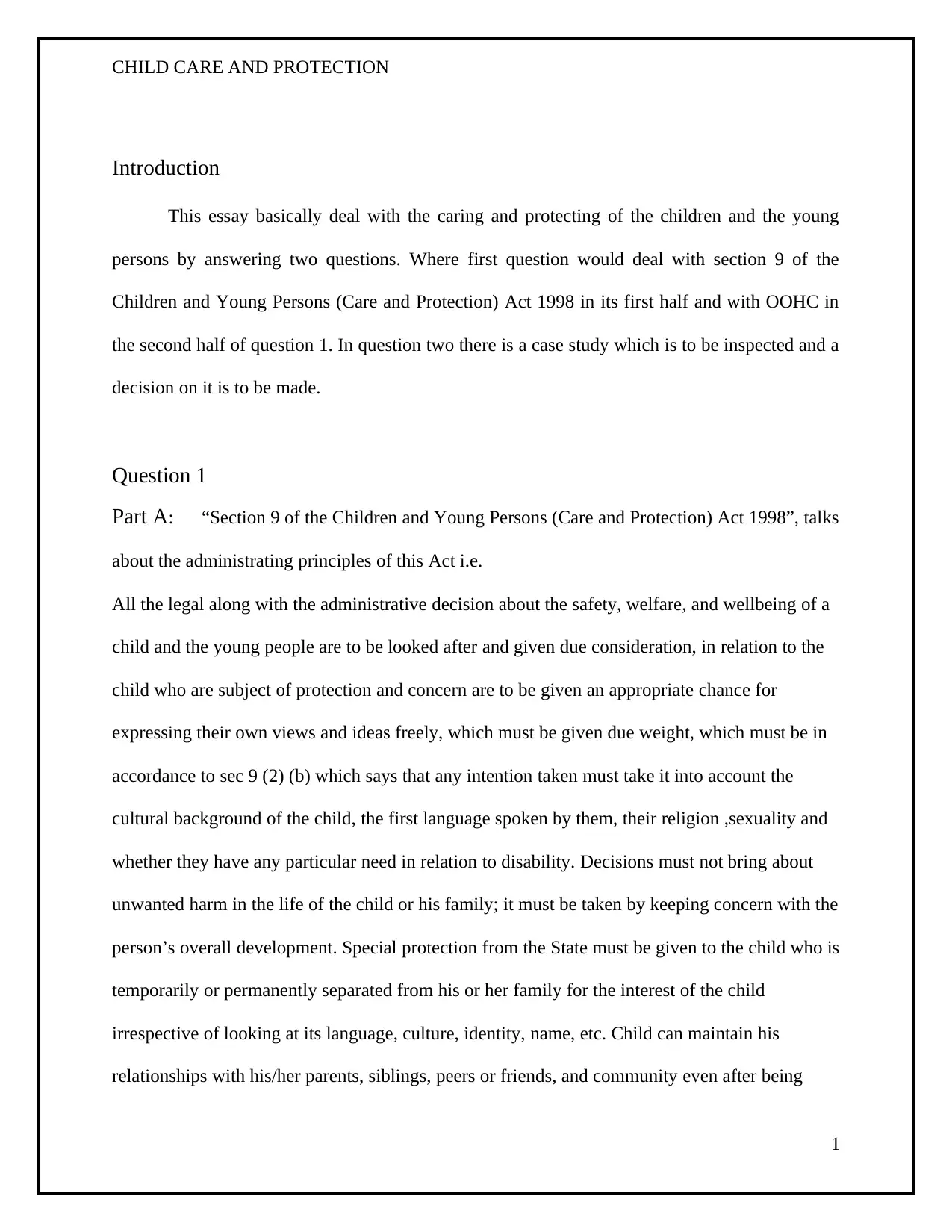
CHILD CARE AND PROTECTION
Introduction
This essay basically deal with the caring and protecting of the children and the young
persons by answering two questions. Where first question would deal with section 9 of the
Children and Young Persons (Care and Protection) Act 1998 in its first half and with OOHC in
the second half of question 1. In question two there is a case study which is to be inspected and a
decision on it is to be made.
Question 1
Part A: “Section 9 of the Children and Young Persons (Care and Protection) Act 1998”, talks
about the administrating principles of this Act i.e.
All the legal along with the administrative decision about the safety, welfare, and wellbeing of a
child and the young people are to be looked after and given due consideration, in relation to the
child who are subject of protection and concern are to be given an appropriate chance for
expressing their own views and ideas freely, which must be given due weight, which must be in
accordance to sec 9 (2) (b) which says that any intention taken must take it into account the
cultural background of the child, the first language spoken by them, their religion ,sexuality and
whether they have any particular need in relation to disability. Decisions must not bring about
unwanted harm in the life of the child or his family; it must be taken by keeping concern with the
person’s overall development. Special protection from the State must be given to the child who is
temporarily or permanently separated from his or her family for the interest of the child
irrespective of looking at its language, culture, identity, name, etc. Child can maintain his
relationships with his/her parents, siblings, peers or friends, and community even after being
1
Introduction
This essay basically deal with the caring and protecting of the children and the young
persons by answering two questions. Where first question would deal with section 9 of the
Children and Young Persons (Care and Protection) Act 1998 in its first half and with OOHC in
the second half of question 1. In question two there is a case study which is to be inspected and a
decision on it is to be made.
Question 1
Part A: “Section 9 of the Children and Young Persons (Care and Protection) Act 1998”, talks
about the administrating principles of this Act i.e.
All the legal along with the administrative decision about the safety, welfare, and wellbeing of a
child and the young people are to be looked after and given due consideration, in relation to the
child who are subject of protection and concern are to be given an appropriate chance for
expressing their own views and ideas freely, which must be given due weight, which must be in
accordance to sec 9 (2) (b) which says that any intention taken must take it into account the
cultural background of the child, the first language spoken by them, their religion ,sexuality and
whether they have any particular need in relation to disability. Decisions must not bring about
unwanted harm in the life of the child or his family; it must be taken by keeping concern with the
person’s overall development. Special protection from the State must be given to the child who is
temporarily or permanently separated from his or her family for the interest of the child
irrespective of looking at its language, culture, identity, name, etc. Child can maintain his
relationships with his/her parents, siblings, peers or friends, and community even after being
1
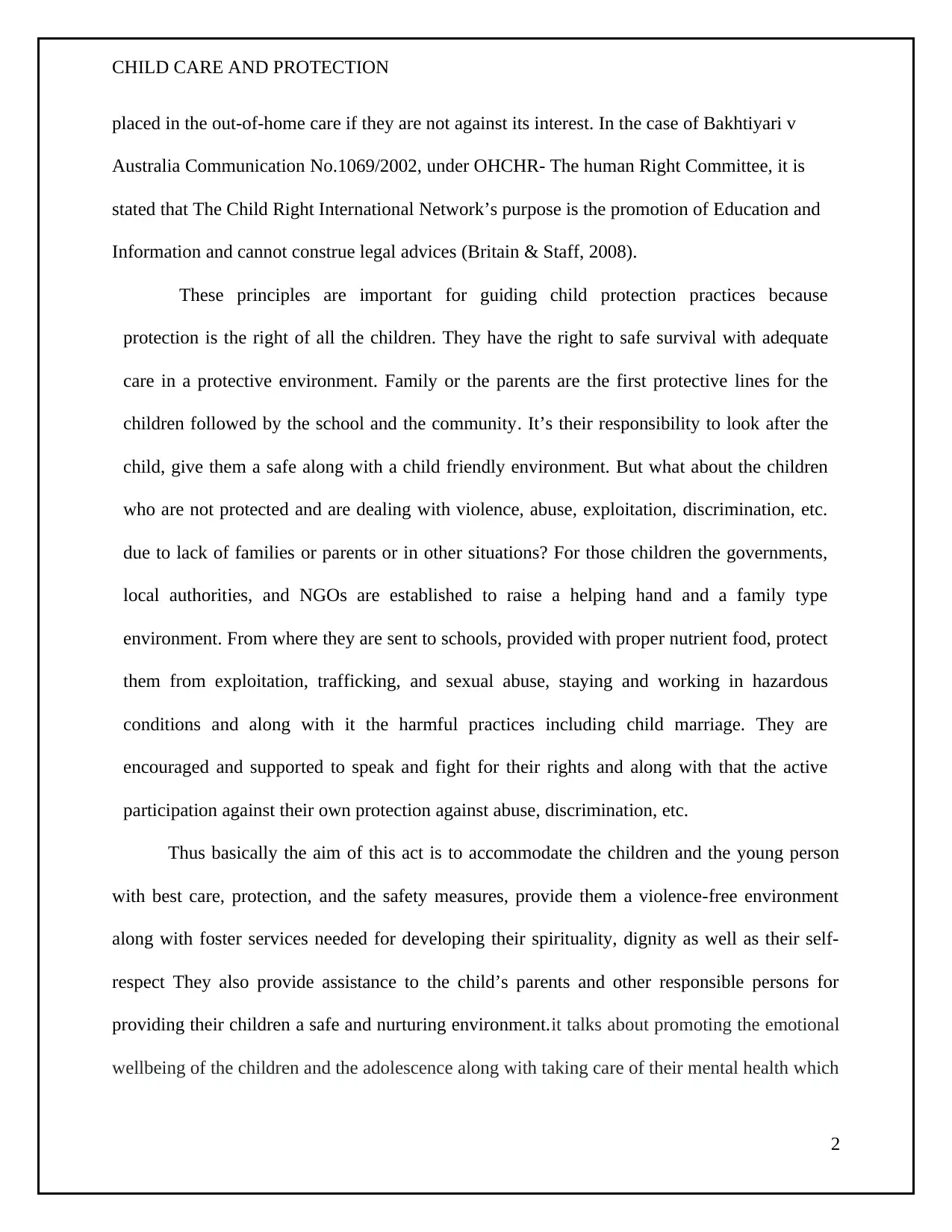
CHILD CARE AND PROTECTION
placed in the out-of-home care if they are not against its interest. In the case of Bakhtiyari v
Australia Communication No.1069/2002, under OHCHR- The human Right Committee, it is
stated that The Child Right International Network’s purpose is the promotion of Education and
Information and cannot construe legal advices (Britain & Staff, 2008).
These principles are important for guiding child protection practices because
protection is the right of all the children. They have the right to safe survival with adequate
care in a protective environment. Family or the parents are the first protective lines for the
children followed by the school and the community. It’s their responsibility to look after the
child, give them a safe along with a child friendly environment. But what about the children
who are not protected and are dealing with violence, abuse, exploitation, discrimination, etc.
due to lack of families or parents or in other situations? For those children the governments,
local authorities, and NGOs are established to raise a helping hand and a family type
environment. From where they are sent to schools, provided with proper nutrient food, protect
them from exploitation, trafficking, and sexual abuse, staying and working in hazardous
conditions and along with it the harmful practices including child marriage. They are
encouraged and supported to speak and fight for their rights and along with that the active
participation against their own protection against abuse, discrimination, etc.
Thus basically the aim of this act is to accommodate the children and the young person
with best care, protection, and the safety measures, provide them a violence-free environment
along with foster services needed for developing their spirituality, dignity as well as their self-
respect They also provide assistance to the child’s parents and other responsible persons for
providing their children a safe and nurturing environment.it talks about promoting the emotional
wellbeing of the children and the adolescence along with taking care of their mental health which
2
placed in the out-of-home care if they are not against its interest. In the case of Bakhtiyari v
Australia Communication No.1069/2002, under OHCHR- The human Right Committee, it is
stated that The Child Right International Network’s purpose is the promotion of Education and
Information and cannot construe legal advices (Britain & Staff, 2008).
These principles are important for guiding child protection practices because
protection is the right of all the children. They have the right to safe survival with adequate
care in a protective environment. Family or the parents are the first protective lines for the
children followed by the school and the community. It’s their responsibility to look after the
child, give them a safe along with a child friendly environment. But what about the children
who are not protected and are dealing with violence, abuse, exploitation, discrimination, etc.
due to lack of families or parents or in other situations? For those children the governments,
local authorities, and NGOs are established to raise a helping hand and a family type
environment. From where they are sent to schools, provided with proper nutrient food, protect
them from exploitation, trafficking, and sexual abuse, staying and working in hazardous
conditions and along with it the harmful practices including child marriage. They are
encouraged and supported to speak and fight for their rights and along with that the active
participation against their own protection against abuse, discrimination, etc.
Thus basically the aim of this act is to accommodate the children and the young person
with best care, protection, and the safety measures, provide them a violence-free environment
along with foster services needed for developing their spirituality, dignity as well as their self-
respect They also provide assistance to the child’s parents and other responsible persons for
providing their children a safe and nurturing environment.it talks about promoting the emotional
wellbeing of the children and the adolescence along with taking care of their mental health which
2
⊘ This is a preview!⊘
Do you want full access?
Subscribe today to unlock all pages.

Trusted by 1+ million students worldwide
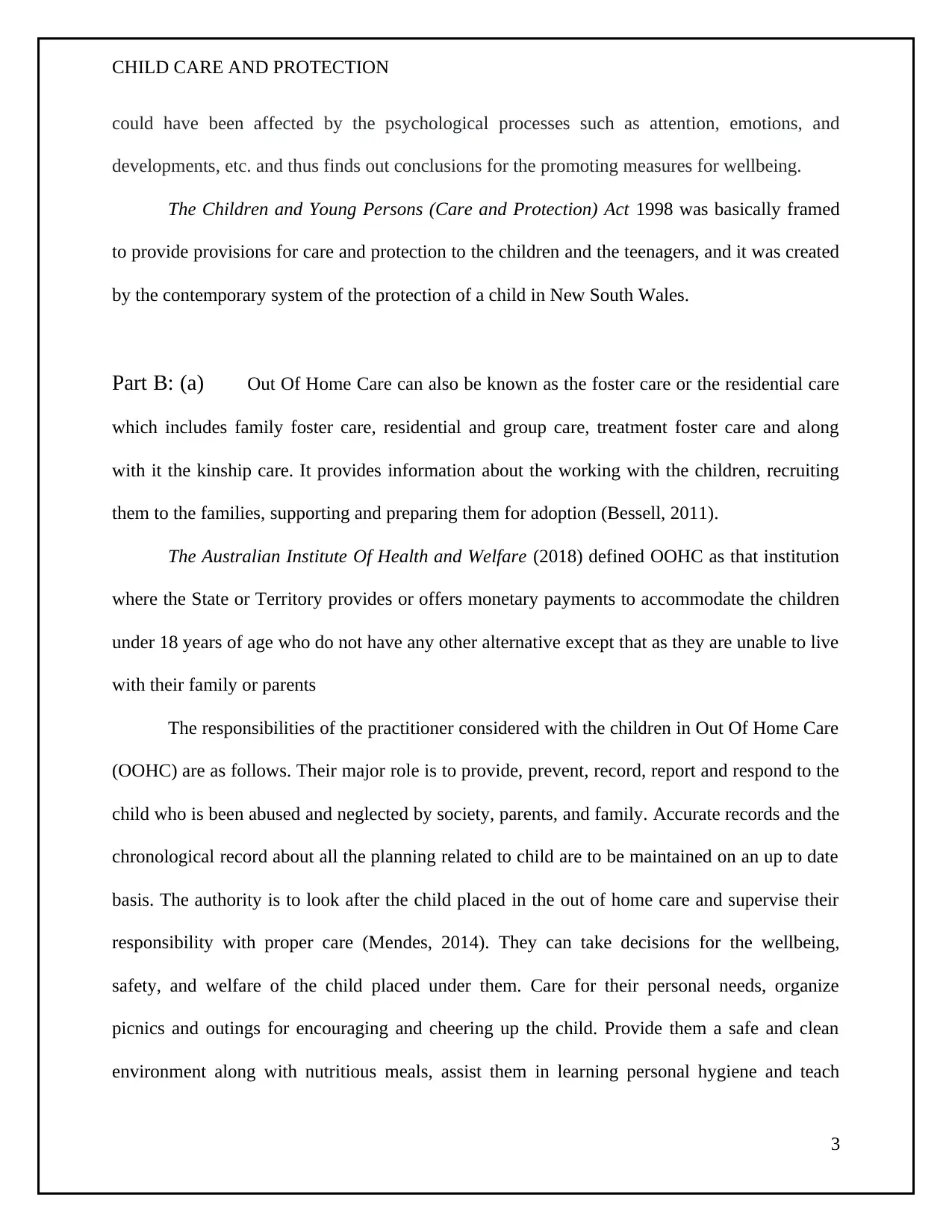
CHILD CARE AND PROTECTION
could have been affected by the psychological processes such as attention, emotions, and
developments, etc. and thus finds out conclusions for the promoting measures for wellbeing.
The Children and Young Persons (Care and Protection) Act 1998 was basically framed
to provide provisions for care and protection to the children and the teenagers, and it was created
by the contemporary system of the protection of a child in New South Wales.
Part B: (a) Out Of Home Care can also be known as the foster care or the residential care
which includes family foster care, residential and group care, treatment foster care and along
with it the kinship care. It provides information about the working with the children, recruiting
them to the families, supporting and preparing them for adoption (Bessell, 2011).
The Australian Institute Of Health and Welfare (2018) defined OOHC as that institution
where the State or Territory provides or offers monetary payments to accommodate the children
under 18 years of age who do not have any other alternative except that as they are unable to live
with their family or parents
The responsibilities of the practitioner considered with the children in Out Of Home Care
(OOHC) are as follows. Their major role is to provide, prevent, record, report and respond to the
child who is been abused and neglected by society, parents, and family. Accurate records and the
chronological record about all the planning related to child are to be maintained on an up to date
basis. The authority is to look after the child placed in the out of home care and supervise their
responsibility with proper care (Mendes, 2014). They can take decisions for the wellbeing,
safety, and welfare of the child placed under them. Care for their personal needs, organize
picnics and outings for encouraging and cheering up the child. Provide them a safe and clean
environment along with nutritious meals, assist them in learning personal hygiene and teach
3
could have been affected by the psychological processes such as attention, emotions, and
developments, etc. and thus finds out conclusions for the promoting measures for wellbeing.
The Children and Young Persons (Care and Protection) Act 1998 was basically framed
to provide provisions for care and protection to the children and the teenagers, and it was created
by the contemporary system of the protection of a child in New South Wales.
Part B: (a) Out Of Home Care can also be known as the foster care or the residential care
which includes family foster care, residential and group care, treatment foster care and along
with it the kinship care. It provides information about the working with the children, recruiting
them to the families, supporting and preparing them for adoption (Bessell, 2011).
The Australian Institute Of Health and Welfare (2018) defined OOHC as that institution
where the State or Territory provides or offers monetary payments to accommodate the children
under 18 years of age who do not have any other alternative except that as they are unable to live
with their family or parents
The responsibilities of the practitioner considered with the children in Out Of Home Care
(OOHC) are as follows. Their major role is to provide, prevent, record, report and respond to the
child who is been abused and neglected by society, parents, and family. Accurate records and the
chronological record about all the planning related to child are to be maintained on an up to date
basis. The authority is to look after the child placed in the out of home care and supervise their
responsibility with proper care (Mendes, 2014). They can take decisions for the wellbeing,
safety, and welfare of the child placed under them. Care for their personal needs, organize
picnics and outings for encouraging and cheering up the child. Provide them a safe and clean
environment along with nutritious meals, assist them in learning personal hygiene and teach
3
Paraphrase This Document
Need a fresh take? Get an instant paraphrase of this document with our AI Paraphraser
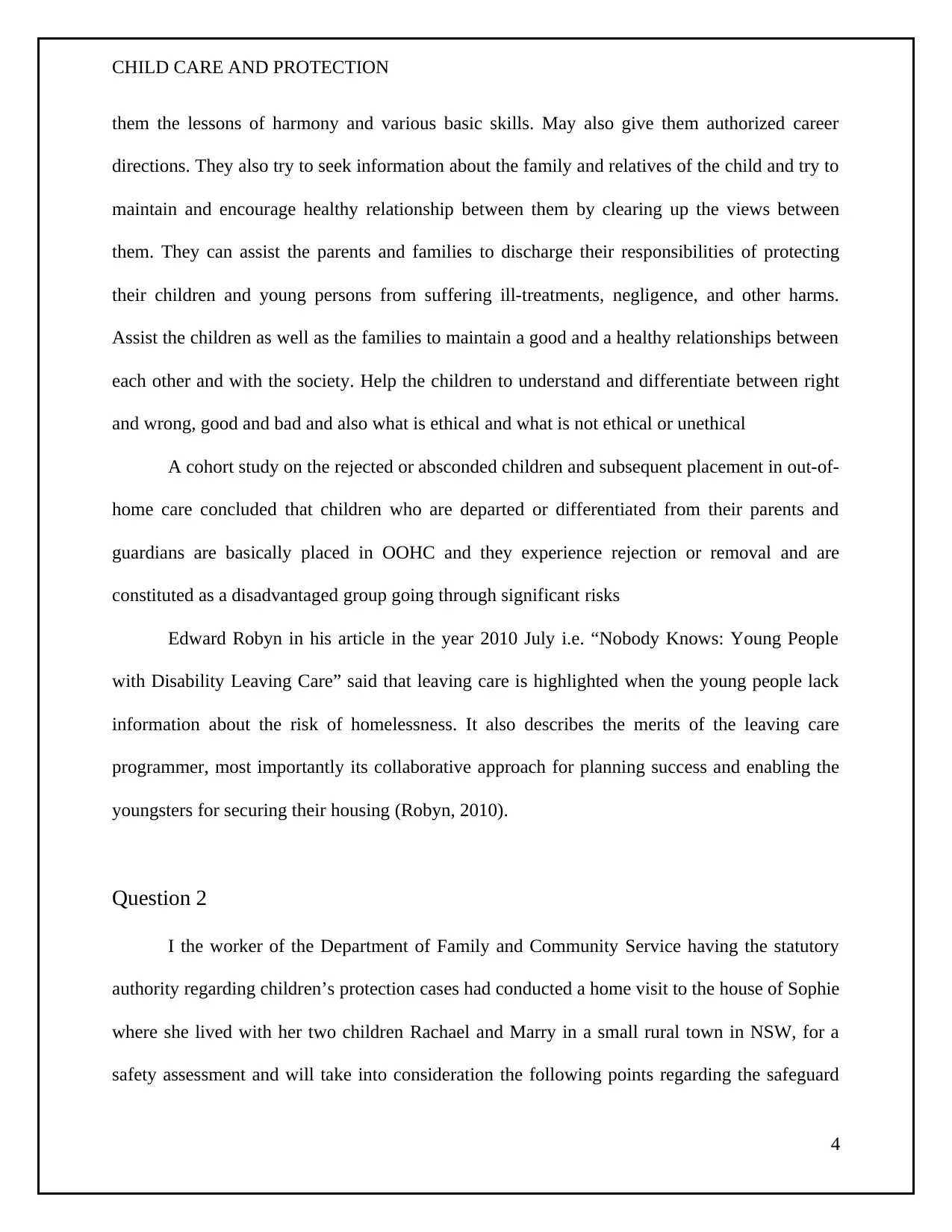
CHILD CARE AND PROTECTION
them the lessons of harmony and various basic skills. May also give them authorized career
directions. They also try to seek information about the family and relatives of the child and try to
maintain and encourage healthy relationship between them by clearing up the views between
them. They can assist the parents and families to discharge their responsibilities of protecting
their children and young persons from suffering ill-treatments, negligence, and other harms.
Assist the children as well as the families to maintain a good and a healthy relationships between
each other and with the society. Help the children to understand and differentiate between right
and wrong, good and bad and also what is ethical and what is not ethical or unethical
A cohort study on the rejected or absconded children and subsequent placement in out-of-
home care concluded that children who are departed or differentiated from their parents and
guardians are basically placed in OOHC and they experience rejection or removal and are
constituted as a disadvantaged group going through significant risks
Edward Robyn in his article in the year 2010 July i.e. “Nobody Knows: Young People
with Disability Leaving Care” said that leaving care is highlighted when the young people lack
information about the risk of homelessness. It also describes the merits of the leaving care
programmer, most importantly its collaborative approach for planning success and enabling the
youngsters for securing their housing (Robyn, 2010).
Question 2
I the worker of the Department of Family and Community Service having the statutory
authority regarding children’s protection cases had conducted a home visit to the house of Sophie
where she lived with her two children Rachael and Marry in a small rural town in NSW, for a
safety assessment and will take into consideration the following points regarding the safeguard
4
them the lessons of harmony and various basic skills. May also give them authorized career
directions. They also try to seek information about the family and relatives of the child and try to
maintain and encourage healthy relationship between them by clearing up the views between
them. They can assist the parents and families to discharge their responsibilities of protecting
their children and young persons from suffering ill-treatments, negligence, and other harms.
Assist the children as well as the families to maintain a good and a healthy relationships between
each other and with the society. Help the children to understand and differentiate between right
and wrong, good and bad and also what is ethical and what is not ethical or unethical
A cohort study on the rejected or absconded children and subsequent placement in out-of-
home care concluded that children who are departed or differentiated from their parents and
guardians are basically placed in OOHC and they experience rejection or removal and are
constituted as a disadvantaged group going through significant risks
Edward Robyn in his article in the year 2010 July i.e. “Nobody Knows: Young People
with Disability Leaving Care” said that leaving care is highlighted when the young people lack
information about the risk of homelessness. It also describes the merits of the leaving care
programmer, most importantly its collaborative approach for planning success and enabling the
youngsters for securing their housing (Robyn, 2010).
Question 2
I the worker of the Department of Family and Community Service having the statutory
authority regarding children’s protection cases had conducted a home visit to the house of Sophie
where she lived with her two children Rachael and Marry in a small rural town in NSW, for a
safety assessment and will take into consideration the following points regarding the safeguard
4
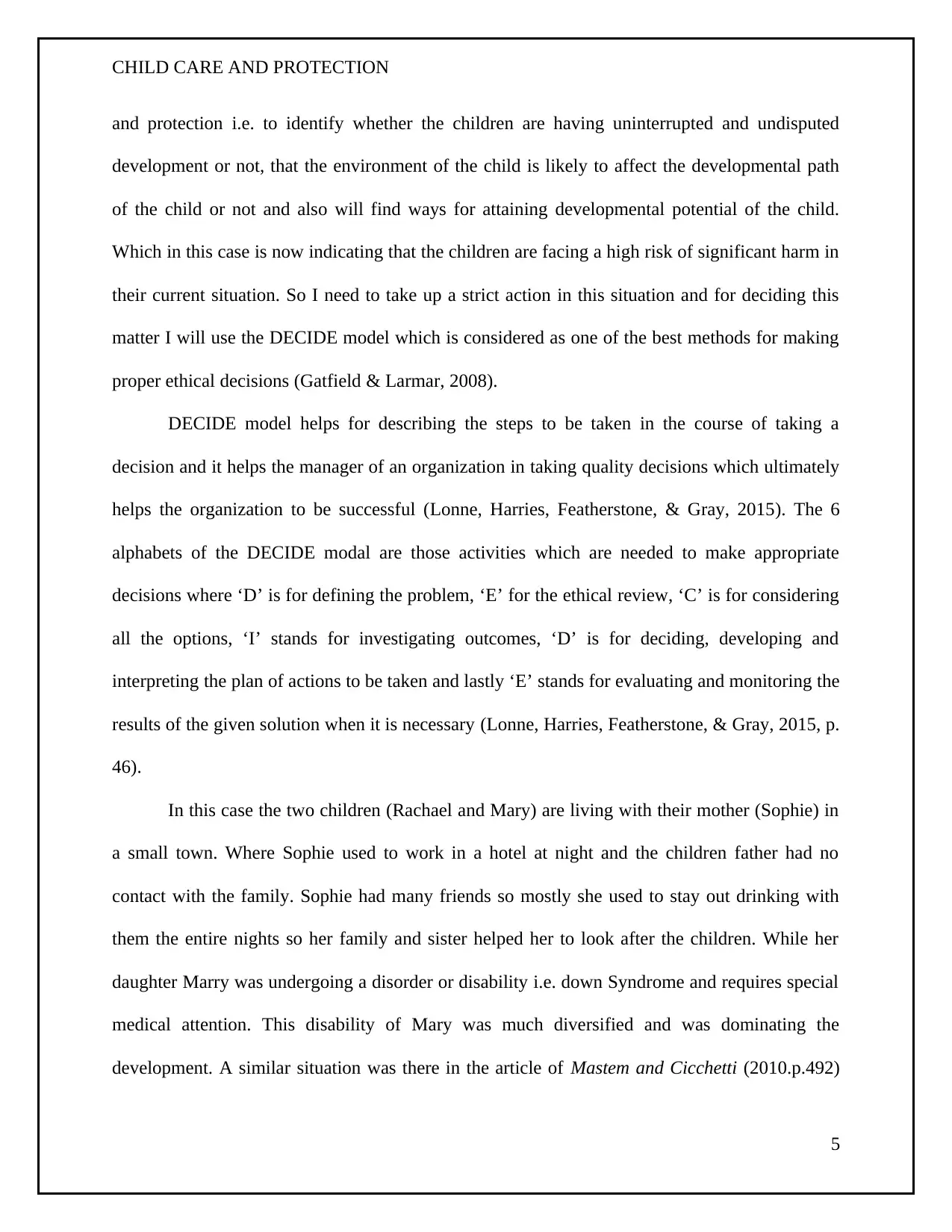
CHILD CARE AND PROTECTION
and protection i.e. to identify whether the children are having uninterrupted and undisputed
development or not, that the environment of the child is likely to affect the developmental path
of the child or not and also will find ways for attaining developmental potential of the child.
Which in this case is now indicating that the children are facing a high risk of significant harm in
their current situation. So I need to take up a strict action in this situation and for deciding this
matter I will use the DECIDE model which is considered as one of the best methods for making
proper ethical decisions (Gatfield & Larmar, 2008).
DECIDE model helps for describing the steps to be taken in the course of taking a
decision and it helps the manager of an organization in taking quality decisions which ultimately
helps the organization to be successful (Lonne, Harries, Featherstone, & Gray, 2015). The 6
alphabets of the DECIDE modal are those activities which are needed to make appropriate
decisions where ‘D’ is for defining the problem, ‘E’ for the ethical review, ‘C’ is for considering
all the options, ‘I’ stands for investigating outcomes, ‘D’ is for deciding, developing and
interpreting the plan of actions to be taken and lastly ‘E’ stands for evaluating and monitoring the
results of the given solution when it is necessary (Lonne, Harries, Featherstone, & Gray, 2015, p.
46).
In this case the two children (Rachael and Mary) are living with their mother (Sophie) in
a small town. Where Sophie used to work in a hotel at night and the children father had no
contact with the family. Sophie had many friends so mostly she used to stay out drinking with
them the entire nights so her family and sister helped her to look after the children. While her
daughter Marry was undergoing a disorder or disability i.e. down Syndrome and requires special
medical attention. This disability of Mary was much diversified and was dominating the
development. A similar situation was there in the article of Mastem and Cicchetti (2010.p.492)
5
and protection i.e. to identify whether the children are having uninterrupted and undisputed
development or not, that the environment of the child is likely to affect the developmental path
of the child or not and also will find ways for attaining developmental potential of the child.
Which in this case is now indicating that the children are facing a high risk of significant harm in
their current situation. So I need to take up a strict action in this situation and for deciding this
matter I will use the DECIDE model which is considered as one of the best methods for making
proper ethical decisions (Gatfield & Larmar, 2008).
DECIDE model helps for describing the steps to be taken in the course of taking a
decision and it helps the manager of an organization in taking quality decisions which ultimately
helps the organization to be successful (Lonne, Harries, Featherstone, & Gray, 2015). The 6
alphabets of the DECIDE modal are those activities which are needed to make appropriate
decisions where ‘D’ is for defining the problem, ‘E’ for the ethical review, ‘C’ is for considering
all the options, ‘I’ stands for investigating outcomes, ‘D’ is for deciding, developing and
interpreting the plan of actions to be taken and lastly ‘E’ stands for evaluating and monitoring the
results of the given solution when it is necessary (Lonne, Harries, Featherstone, & Gray, 2015, p.
46).
In this case the two children (Rachael and Mary) are living with their mother (Sophie) in
a small town. Where Sophie used to work in a hotel at night and the children father had no
contact with the family. Sophie had many friends so mostly she used to stay out drinking with
them the entire nights so her family and sister helped her to look after the children. While her
daughter Marry was undergoing a disorder or disability i.e. down Syndrome and requires special
medical attention. This disability of Mary was much diversified and was dominating the
development. A similar situation was there in the article of Mastem and Cicchetti (2010.p.492)
5
⊘ This is a preview!⊘
Do you want full access?
Subscribe today to unlock all pages.

Trusted by 1+ million students worldwide
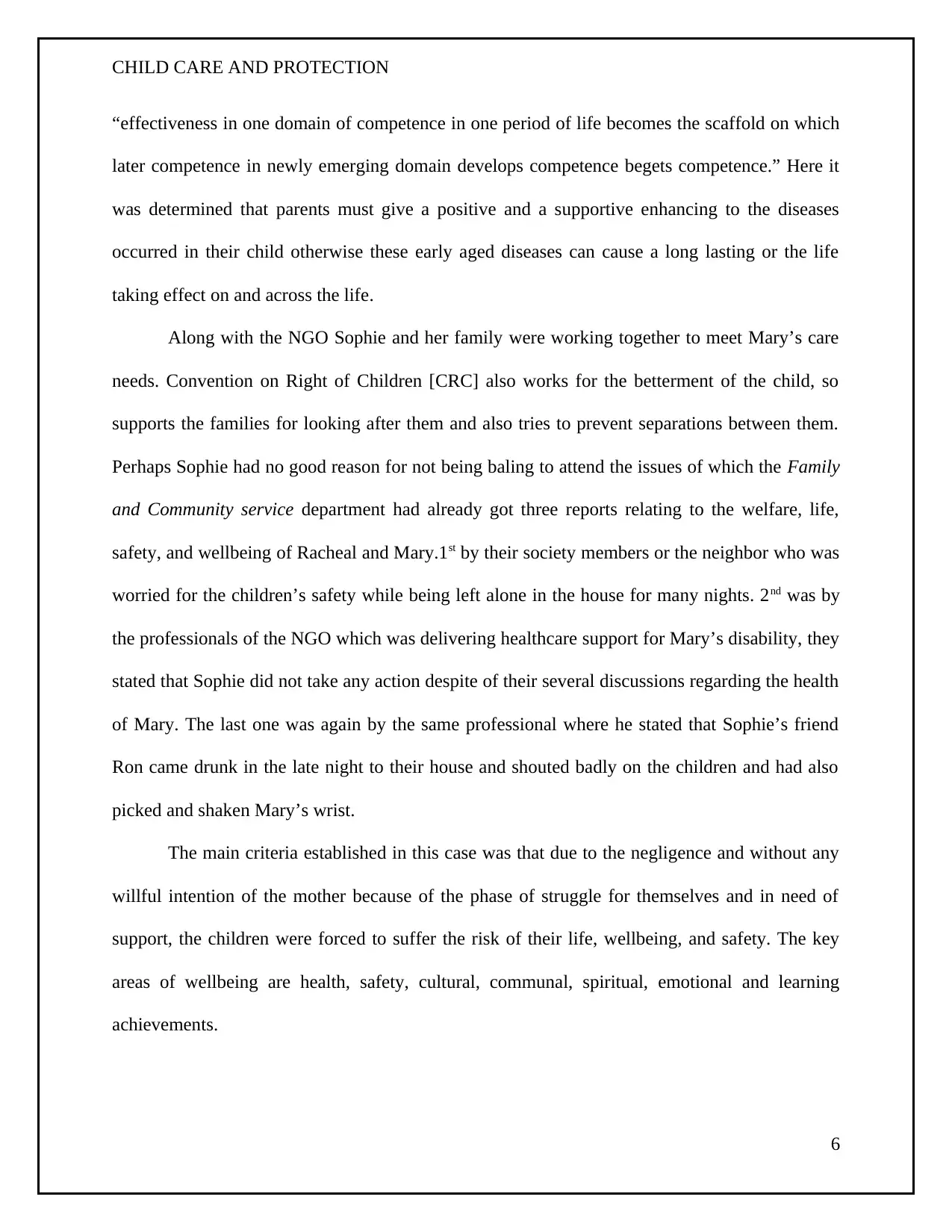
CHILD CARE AND PROTECTION
“effectiveness in one domain of competence in one period of life becomes the scaffold on which
later competence in newly emerging domain develops competence begets competence.” Here it
was determined that parents must give a positive and a supportive enhancing to the diseases
occurred in their child otherwise these early aged diseases can cause a long lasting or the life
taking effect on and across the life.
Along with the NGO Sophie and her family were working together to meet Mary’s care
needs. Convention on Right of Children [CRC] also works for the betterment of the child, so
supports the families for looking after them and also tries to prevent separations between them.
Perhaps Sophie had no good reason for not being baling to attend the issues of which the Family
and Community service department had already got three reports relating to the welfare, life,
safety, and wellbeing of Racheal and Mary.1st by their society members or the neighbor who was
worried for the children’s safety while being left alone in the house for many nights. 2nd was by
the professionals of the NGO which was delivering healthcare support for Mary’s disability, they
stated that Sophie did not take any action despite of their several discussions regarding the health
of Mary. The last one was again by the same professional where he stated that Sophie’s friend
Ron came drunk in the late night to their house and shouted badly on the children and had also
picked and shaken Mary’s wrist.
The main criteria established in this case was that due to the negligence and without any
willful intention of the mother because of the phase of struggle for themselves and in need of
support, the children were forced to suffer the risk of their life, wellbeing, and safety. The key
areas of wellbeing are health, safety, cultural, communal, spiritual, emotional and learning
achievements.
6
“effectiveness in one domain of competence in one period of life becomes the scaffold on which
later competence in newly emerging domain develops competence begets competence.” Here it
was determined that parents must give a positive and a supportive enhancing to the diseases
occurred in their child otherwise these early aged diseases can cause a long lasting or the life
taking effect on and across the life.
Along with the NGO Sophie and her family were working together to meet Mary’s care
needs. Convention on Right of Children [CRC] also works for the betterment of the child, so
supports the families for looking after them and also tries to prevent separations between them.
Perhaps Sophie had no good reason for not being baling to attend the issues of which the Family
and Community service department had already got three reports relating to the welfare, life,
safety, and wellbeing of Racheal and Mary.1st by their society members or the neighbor who was
worried for the children’s safety while being left alone in the house for many nights. 2nd was by
the professionals of the NGO which was delivering healthcare support for Mary’s disability, they
stated that Sophie did not take any action despite of their several discussions regarding the health
of Mary. The last one was again by the same professional where he stated that Sophie’s friend
Ron came drunk in the late night to their house and shouted badly on the children and had also
picked and shaken Mary’s wrist.
The main criteria established in this case was that due to the negligence and without any
willful intention of the mother because of the phase of struggle for themselves and in need of
support, the children were forced to suffer the risk of their life, wellbeing, and safety. The key
areas of wellbeing are health, safety, cultural, communal, spiritual, emotional and learning
achievements.
6
Paraphrase This Document
Need a fresh take? Get an instant paraphrase of this document with our AI Paraphraser
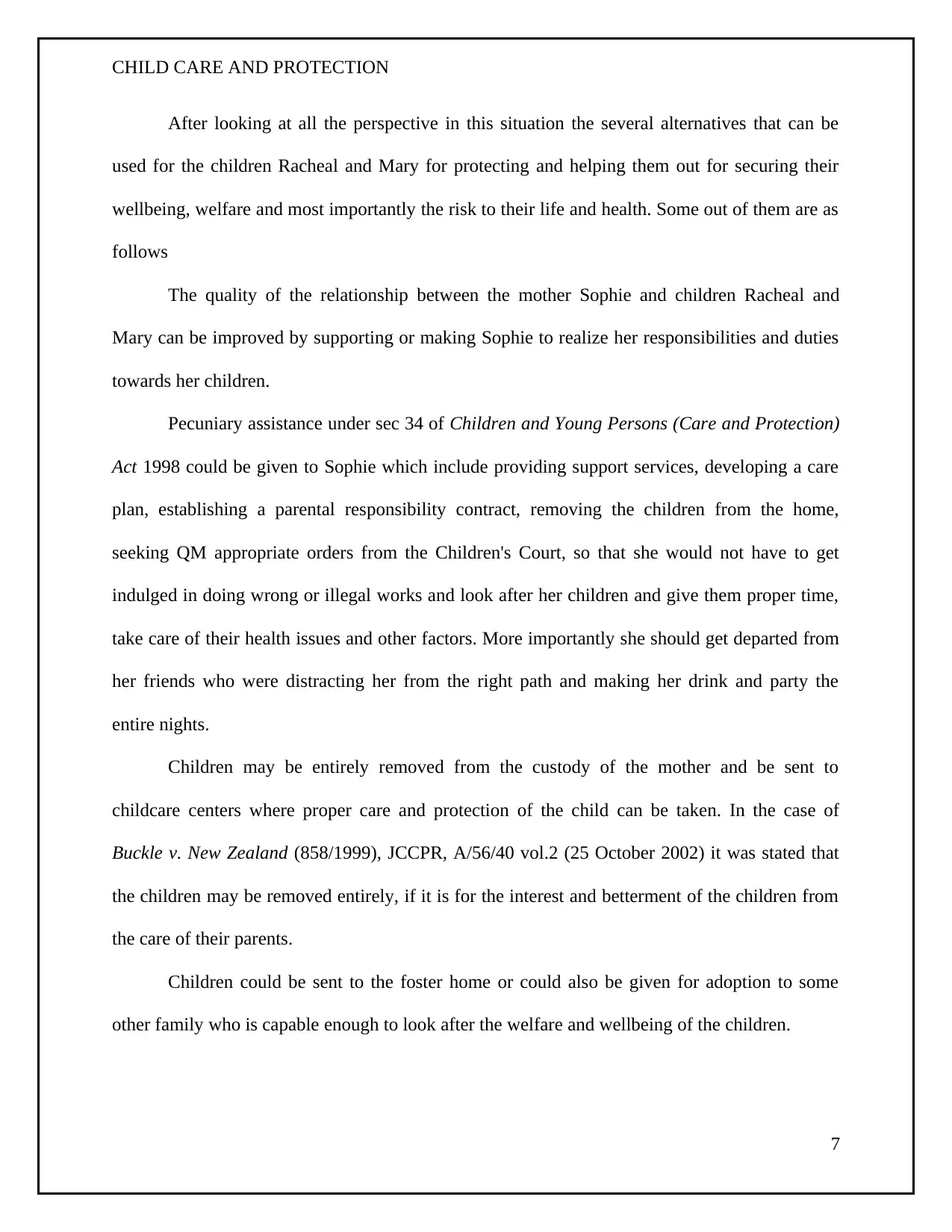
CHILD CARE AND PROTECTION
After looking at all the perspective in this situation the several alternatives that can be
used for the children Racheal and Mary for protecting and helping them out for securing their
wellbeing, welfare and most importantly the risk to their life and health. Some out of them are as
follows
The quality of the relationship between the mother Sophie and children Racheal and
Mary can be improved by supporting or making Sophie to realize her responsibilities and duties
towards her children.
Pecuniary assistance under sec 34 of Children and Young Persons (Care and Protection)
Act 1998 could be given to Sophie which include providing support services, developing a care
plan, establishing a parental responsibility contract, removing the children from the home,
seeking QM appropriate orders from the Children's Court, so that she would not have to get
indulged in doing wrong or illegal works and look after her children and give them proper time,
take care of their health issues and other factors. More importantly she should get departed from
her friends who were distracting her from the right path and making her drink and party the
entire nights.
Children may be entirely removed from the custody of the mother and be sent to
childcare centers where proper care and protection of the child can be taken. In the case of
Buckle v. New Zealand (858/1999), JCCPR, A/56/40 vol.2 (25 October 2002) it was stated that
the children may be removed entirely, if it is for the interest and betterment of the children from
the care of their parents.
Children could be sent to the foster home or could also be given for adoption to some
other family who is capable enough to look after the welfare and wellbeing of the children.
7
After looking at all the perspective in this situation the several alternatives that can be
used for the children Racheal and Mary for protecting and helping them out for securing their
wellbeing, welfare and most importantly the risk to their life and health. Some out of them are as
follows
The quality of the relationship between the mother Sophie and children Racheal and
Mary can be improved by supporting or making Sophie to realize her responsibilities and duties
towards her children.
Pecuniary assistance under sec 34 of Children and Young Persons (Care and Protection)
Act 1998 could be given to Sophie which include providing support services, developing a care
plan, establishing a parental responsibility contract, removing the children from the home,
seeking QM appropriate orders from the Children's Court, so that she would not have to get
indulged in doing wrong or illegal works and look after her children and give them proper time,
take care of their health issues and other factors. More importantly she should get departed from
her friends who were distracting her from the right path and making her drink and party the
entire nights.
Children may be entirely removed from the custody of the mother and be sent to
childcare centers where proper care and protection of the child can be taken. In the case of
Buckle v. New Zealand (858/1999), JCCPR, A/56/40 vol.2 (25 October 2002) it was stated that
the children may be removed entirely, if it is for the interest and betterment of the children from
the care of their parents.
Children could be sent to the foster home or could also be given for adoption to some
other family who is capable enough to look after the welfare and wellbeing of the children.
7
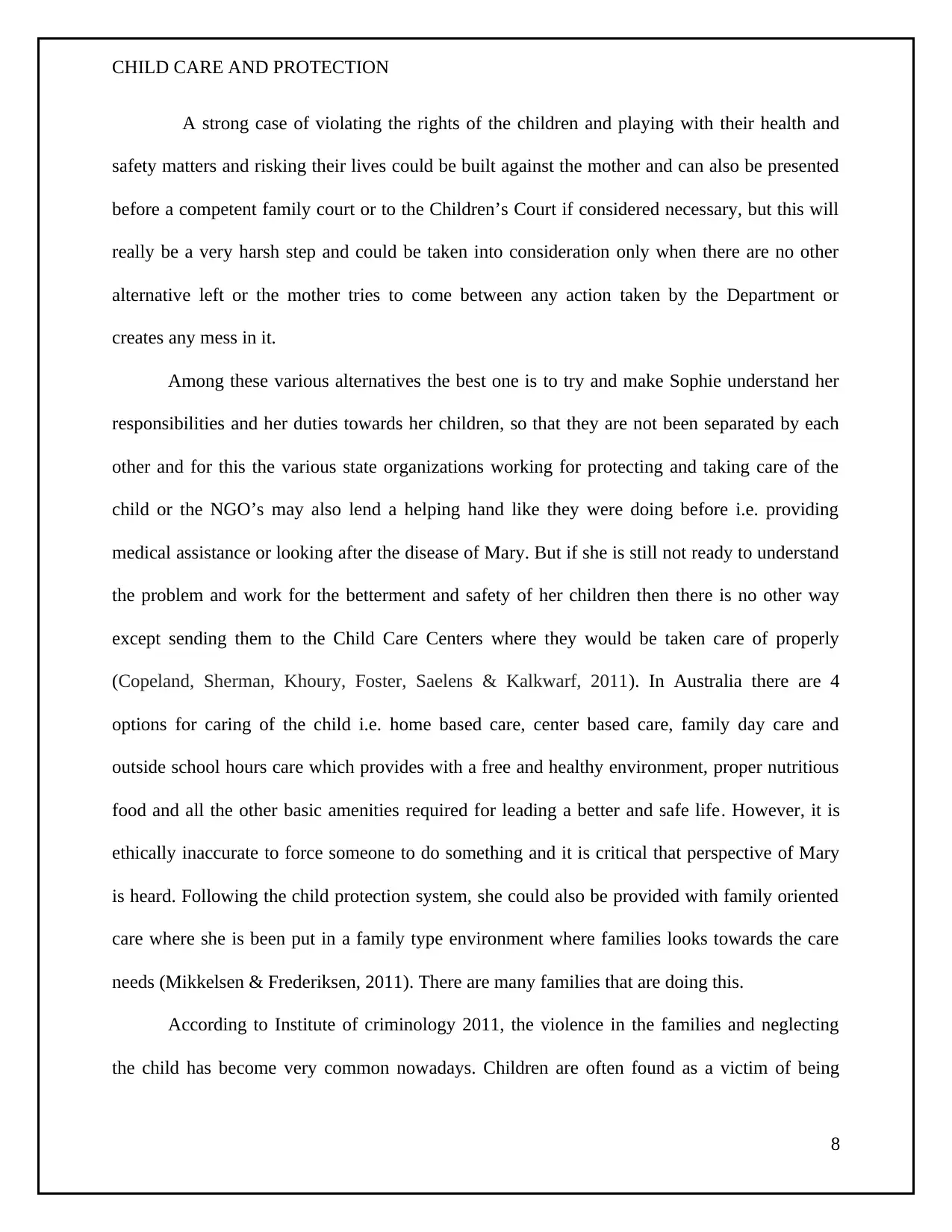
CHILD CARE AND PROTECTION
A strong case of violating the rights of the children and playing with their health and
safety matters and risking their lives could be built against the mother and can also be presented
before a competent family court or to the Children’s Court if considered necessary, but this will
really be a very harsh step and could be taken into consideration only when there are no other
alternative left or the mother tries to come between any action taken by the Department or
creates any mess in it.
Among these various alternatives the best one is to try and make Sophie understand her
responsibilities and her duties towards her children, so that they are not been separated by each
other and for this the various state organizations working for protecting and taking care of the
child or the NGO’s may also lend a helping hand like they were doing before i.e. providing
medical assistance or looking after the disease of Mary. But if she is still not ready to understand
the problem and work for the betterment and safety of her children then there is no other way
except sending them to the Child Care Centers where they would be taken care of properly
(Copeland, Sherman, Khoury, Foster, Saelens & Kalkwarf, 2011). In Australia there are 4
options for caring of the child i.e. home based care, center based care, family day care and
outside school hours care which provides with a free and healthy environment, proper nutritious
food and all the other basic amenities required for leading a better and safe life. However, it is
ethically inaccurate to force someone to do something and it is critical that perspective of Mary
is heard. Following the child protection system, she could also be provided with family oriented
care where she is been put in a family type environment where families looks towards the care
needs (Mikkelsen & Frederiksen, 2011). There are many families that are doing this.
According to Institute of criminology 2011, the violence in the families and neglecting
the child has become very common nowadays. Children are often found as a victim of being
8
A strong case of violating the rights of the children and playing with their health and
safety matters and risking their lives could be built against the mother and can also be presented
before a competent family court or to the Children’s Court if considered necessary, but this will
really be a very harsh step and could be taken into consideration only when there are no other
alternative left or the mother tries to come between any action taken by the Department or
creates any mess in it.
Among these various alternatives the best one is to try and make Sophie understand her
responsibilities and her duties towards her children, so that they are not been separated by each
other and for this the various state organizations working for protecting and taking care of the
child or the NGO’s may also lend a helping hand like they were doing before i.e. providing
medical assistance or looking after the disease of Mary. But if she is still not ready to understand
the problem and work for the betterment and safety of her children then there is no other way
except sending them to the Child Care Centers where they would be taken care of properly
(Copeland, Sherman, Khoury, Foster, Saelens & Kalkwarf, 2011). In Australia there are 4
options for caring of the child i.e. home based care, center based care, family day care and
outside school hours care which provides with a free and healthy environment, proper nutritious
food and all the other basic amenities required for leading a better and safe life. However, it is
ethically inaccurate to force someone to do something and it is critical that perspective of Mary
is heard. Following the child protection system, she could also be provided with family oriented
care where she is been put in a family type environment where families looks towards the care
needs (Mikkelsen & Frederiksen, 2011). There are many families that are doing this.
According to Institute of criminology 2011, the violence in the families and neglecting
the child has become very common nowadays. Children are often found as a victim of being
8
⊘ This is a preview!⊘
Do you want full access?
Subscribe today to unlock all pages.

Trusted by 1+ million students worldwide
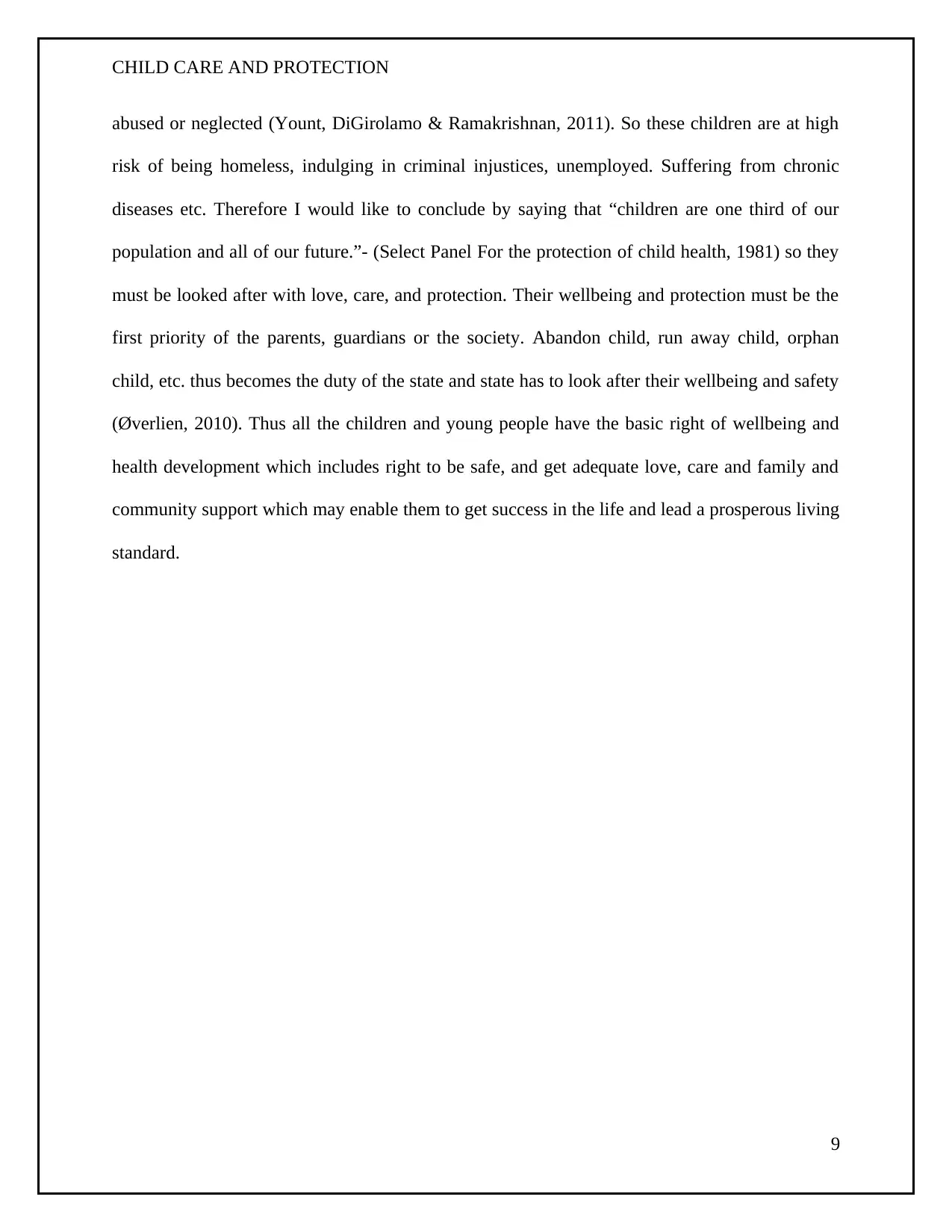
CHILD CARE AND PROTECTION
abused or neglected (Yount, DiGirolamo & Ramakrishnan, 2011). So these children are at high
risk of being homeless, indulging in criminal injustices, unemployed. Suffering from chronic
diseases etc. Therefore I would like to conclude by saying that “children are one third of our
population and all of our future.”- (Select Panel For the protection of child health, 1981) so they
must be looked after with love, care, and protection. Their wellbeing and protection must be the
first priority of the parents, guardians or the society. Abandon child, run away child, orphan
child, etc. thus becomes the duty of the state and state has to look after their wellbeing and safety
(Øverlien, 2010). Thus all the children and young people have the basic right of wellbeing and
health development which includes right to be safe, and get adequate love, care and family and
community support which may enable them to get success in the life and lead a prosperous living
standard.
9
abused or neglected (Yount, DiGirolamo & Ramakrishnan, 2011). So these children are at high
risk of being homeless, indulging in criminal injustices, unemployed. Suffering from chronic
diseases etc. Therefore I would like to conclude by saying that “children are one third of our
population and all of our future.”- (Select Panel For the protection of child health, 1981) so they
must be looked after with love, care, and protection. Their wellbeing and protection must be the
first priority of the parents, guardians or the society. Abandon child, run away child, orphan
child, etc. thus becomes the duty of the state and state has to look after their wellbeing and safety
(Øverlien, 2010). Thus all the children and young people have the basic right of wellbeing and
health development which includes right to be safe, and get adequate love, care and family and
community support which may enable them to get success in the life and lead a prosperous living
standard.
9
Paraphrase This Document
Need a fresh take? Get an instant paraphrase of this document with our AI Paraphraser
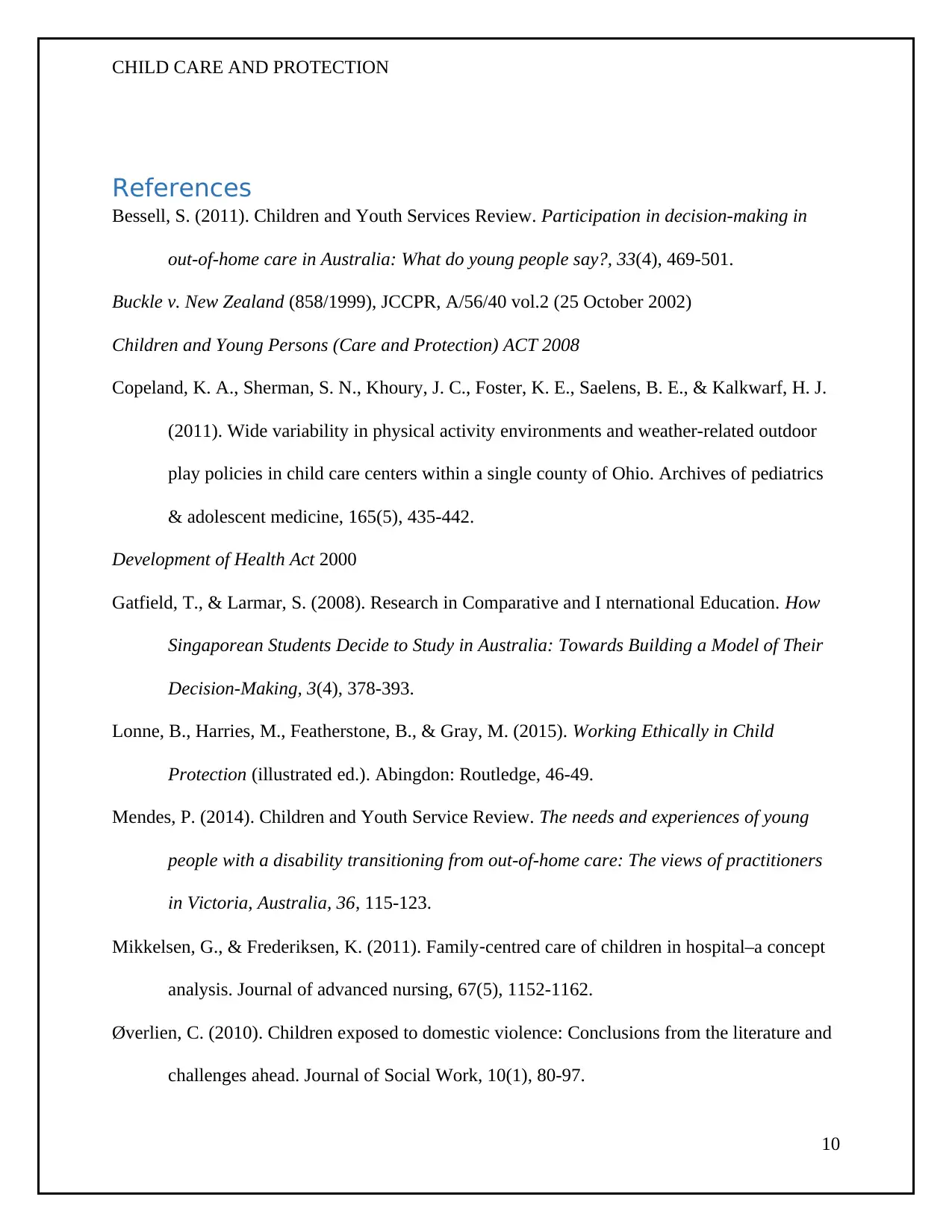
CHILD CARE AND PROTECTION
References
Bessell, S. (2011). Children and Youth Services Review. Participation in decision-making in
out-of-home care in Australia: What do young people say?, 33(4), 469-501.
Buckle v. New Zealand (858/1999), JCCPR, A/56/40 vol.2 (25 October 2002)
Children and Young Persons (Care and Protection) ACT 2008
Copeland, K. A., Sherman, S. N., Khoury, J. C., Foster, K. E., Saelens, B. E., & Kalkwarf, H. J.
(2011). Wide variability in physical activity environments and weather-related outdoor
play policies in child care centers within a single county of Ohio. Archives of pediatrics
& adolescent medicine, 165(5), 435-442.
Development of Health Act 2000
Gatfield, T., & Larmar, S. (2008). Research in Comparative and I nternational Education. How
Singaporean Students Decide to Study in Australia: Towards Building a Model of Their
Decision-Making, 3(4), 378-393.
Lonne, B., Harries, M., Featherstone, B., & Gray, M. (2015). Working Ethically in Child
Protection (illustrated ed.). Abingdon: Routledge, 46-49.
Mendes, P. (2014). Children and Youth Service Review. The needs and experiences of young
people with a disability transitioning from out-of-home care: The views of practitioners
in Victoria, Australia, 36, 115-123.
Mikkelsen, G., & Frederiksen, K. (2011). Family‐centred care of children in hospital–a concept
analysis. Journal of advanced nursing, 67(5), 1152-1162.
Øverlien, C. (2010). Children exposed to domestic violence: Conclusions from the literature and
challenges ahead. Journal of Social Work, 10(1), 80-97.
10
References
Bessell, S. (2011). Children and Youth Services Review. Participation in decision-making in
out-of-home care in Australia: What do young people say?, 33(4), 469-501.
Buckle v. New Zealand (858/1999), JCCPR, A/56/40 vol.2 (25 October 2002)
Children and Young Persons (Care and Protection) ACT 2008
Copeland, K. A., Sherman, S. N., Khoury, J. C., Foster, K. E., Saelens, B. E., & Kalkwarf, H. J.
(2011). Wide variability in physical activity environments and weather-related outdoor
play policies in child care centers within a single county of Ohio. Archives of pediatrics
& adolescent medicine, 165(5), 435-442.
Development of Health Act 2000
Gatfield, T., & Larmar, S. (2008). Research in Comparative and I nternational Education. How
Singaporean Students Decide to Study in Australia: Towards Building a Model of Their
Decision-Making, 3(4), 378-393.
Lonne, B., Harries, M., Featherstone, B., & Gray, M. (2015). Working Ethically in Child
Protection (illustrated ed.). Abingdon: Routledge, 46-49.
Mendes, P. (2014). Children and Youth Service Review. The needs and experiences of young
people with a disability transitioning from out-of-home care: The views of practitioners
in Victoria, Australia, 36, 115-123.
Mikkelsen, G., & Frederiksen, K. (2011). Family‐centred care of children in hospital–a concept
analysis. Journal of advanced nursing, 67(5), 1152-1162.
Øverlien, C. (2010). Children exposed to domestic violence: Conclusions from the literature and
challenges ahead. Journal of Social Work, 10(1), 80-97.
10
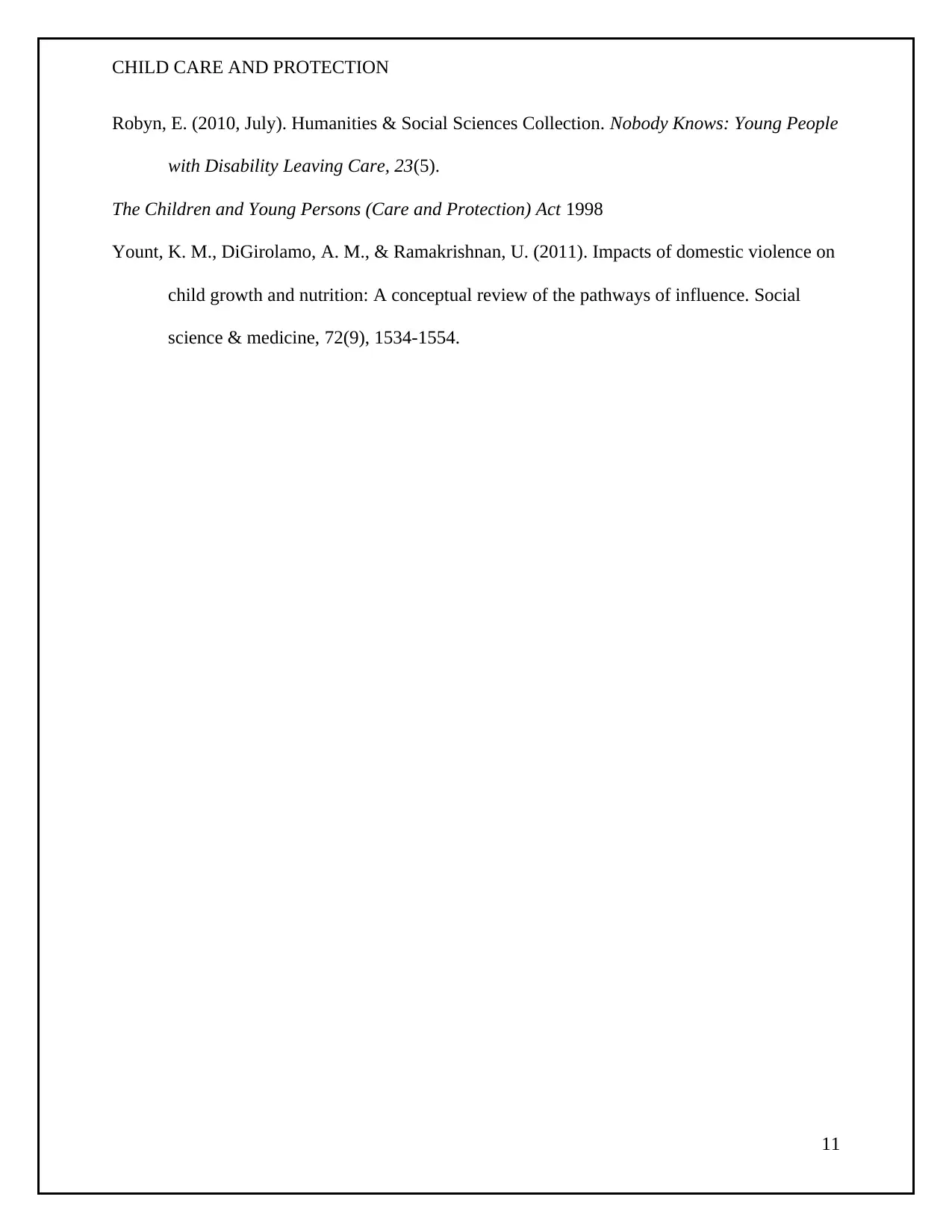
CHILD CARE AND PROTECTION
Robyn, E. (2010, July). Humanities & Social Sciences Collection. Nobody Knows: Young People
with Disability Leaving Care, 23(5).
The Children and Young Persons (Care and Protection) Act 1998
Yount, K. M., DiGirolamo, A. M., & Ramakrishnan, U. (2011). Impacts of domestic violence on
child growth and nutrition: A conceptual review of the pathways of influence. Social
science & medicine, 72(9), 1534-1554.
11
Robyn, E. (2010, July). Humanities & Social Sciences Collection. Nobody Knows: Young People
with Disability Leaving Care, 23(5).
The Children and Young Persons (Care and Protection) Act 1998
Yount, K. M., DiGirolamo, A. M., & Ramakrishnan, U. (2011). Impacts of domestic violence on
child growth and nutrition: A conceptual review of the pathways of influence. Social
science & medicine, 72(9), 1534-1554.
11
⊘ This is a preview!⊘
Do you want full access?
Subscribe today to unlock all pages.

Trusted by 1+ million students worldwide
1 out of 12
Related Documents
Your All-in-One AI-Powered Toolkit for Academic Success.
+13062052269
info@desklib.com
Available 24*7 on WhatsApp / Email
![[object Object]](/_next/static/media/star-bottom.7253800d.svg)
Unlock your academic potential
Copyright © 2020–2025 A2Z Services. All Rights Reserved. Developed and managed by ZUCOL.





